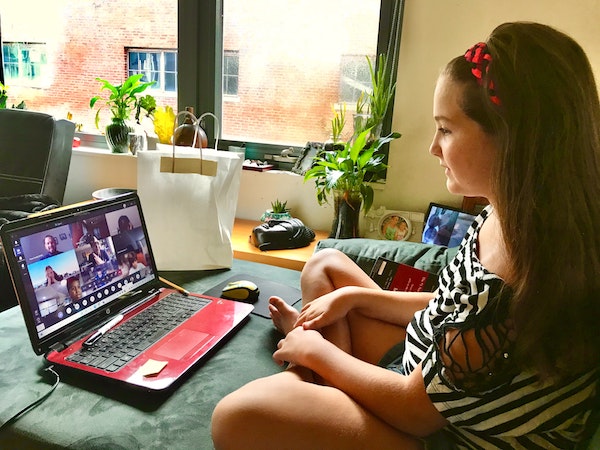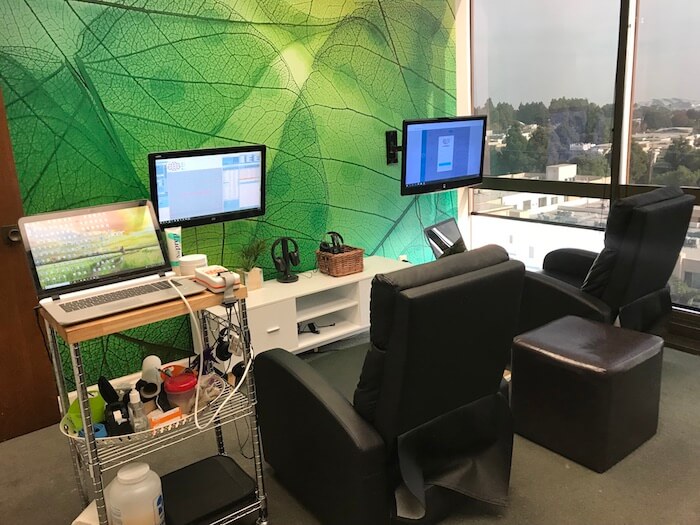Children’s social development during distance learning is a major concern for parents as they navigate the pandemic. Distance learning, also called remote learning, poses significant new challenges to parents, children, and educators. All of us have had to learn a new dynamic on the fly while managing the ever-changing situation that results from the pandemic.
First, take a deep breath and congratulate yourself for managing these once-in- a-century circumstances so far. Parenting is never ever easy, and parents now face unique challenges. To be blunt, distance learning is extremely difficult for all involved. Parents have to juggle working from home or even from the office with essentially trying to homeschool their children. Trying to keep your kids on task is challenging enough, but when you add in social development and how to manage that, it can seem impossible at times. You can take some comfort knowing that you aren’t alone. All of us struggle when trying to balance so many factors at once. It’s okay to feel overwhelmed and need a little help.
Erin Badour, MS, CCC-SLP specializes in helping families manage these difficult situations so they can thrive and grow. You can transform obstacles into opportunities. If you find yourself struggling to figure out how to do so, contact NeuroZone and schedule your free initial consultation. We have three conveniently located offices in Playa del Rey, Santa Monica, and Redondo Beach. You can reach our offices by calling (310) 821-3640.
Physical Distance Is Not Social Distance

It’s important to recognize that distance learning does not mean social isolation. We have to explore new ways of maintaining social connections. Many child development specialists believe that a year of distance learning won’t adversely affect social development in the long term.[1] But it’s still important to manage social development to ensure your children have the best opportunities to thrive. Even with your children physically distant from their friends and extended family, you can help them maintain social intimacy.
Encouraging Healthy Social Development
Online Social Contact
Reach out to friends and family over Zoom, Skype, or FaceTime. While it might not be the same as gathering at a house for a play date, children can still benefit from seeing and hearing their friends and family. Reach out to loved ones and try to schedule some time to connect your children to their friends and relatives online.
Find a Penpal
Grab a pen and paper and write letters. For thousands of years, humanity survived without the instant gratification of digital communication. Writing letters has long been an important point of social interaction for millennia. From mathematicians Ada Lovelace and Charles Babbage to writers Edith Wharton and Henry James, writing letters has long provided an important source of social contact. For our grandparents or great-parents who immigrated to a new country, letter writing was often the only form of communication between families. Today’s children can experience long term benefits from practicing this classic form of communication.
Household Interaction
Balance household social interaction with private time. This is especially important for siblings around the same age that might enjoy each other’s company sometimes, yet fall into sibling bickering at others. Children with siblings have the advantage of being able to interact in person with others of their age group but it’s important to allow children to have their own private time as well.
Drive-By Celebrations
While not ideal in normal times, many families and friend groups have begun practices of driving by a friend’s or family member’s home for events such as birthdays and graduations. Drop off a gift and see friends from a safe, social distance. Often, the parents hosting will pack pizza or a treat to-go while the visitors can sing a happy birthday song from their cars or deliver balloons. This sends a positive message to children that their friends and family still remember and care about them. Even if it’s not the same as hosting a party, it still allows kids to have some form of social interaction on special days. Even without a special occasion to celebrate, meeting friends and family at a drive-in movie, for instance, can provide an outlet to be able to see people outside your household.
To Let’s Talk Screen Time
Media devices are often the elephant in the room. An easy solution to managing children at home while you work from home might be to simply plant them in front of a TV, tablet, or smartphone and let them entertain themselves. We’ve all done this at times. In moderation, there is nothing wrong with it. But it can become problematic if children just replace social interaction with unsupervised access to media.
For some children, playing video games with their friends during distance learning is an important social outlet. This should be encouraged within healthy parameters. Older children talking online to their friends while playing video games can be a very healthy means of maintaining relationships and reconnecting with some degree of normalcy. However, staying up until 4:30 a.m. playing online games when school starts at 8:15 a.m. crosses the threshold from healthy social maintenance to unhealthy excess. Set rules and boundaries and help shape a balance for your older children that recognizes the benefits of communal gaming while staying aware of the dangers of excessive video game playing.
Don’t Forget to Manage Your Own Stress
Research shows that exposure to chronic stress can alter the brain and physiology in a way that affects health and development over a long period of time.[2][3] An important step in protecting our children from bearing the brunt of chronic stress is managing our own stress as adults. If adults can manage their own stress in a healthy way, it protects children from the worst effects of chronic stress.
The 1997 Academy Award-winning film Life Is Beautiful provides a great example of adults striving to protect children from feeling the worst effects of a monumentally stressful situation: a Nazi concentration camp during World War II. We can all take inspiration from Roberto Benigni’s character who endeavors to shield his son from the stress he himself experiences. It’s important for adults to manage their own stress so they can help their children.
Practicing self-care is extremely important during this time.
Some Tips for Managing Stress for Adults
- Keep eating healthy – while it’s okay to treat yourself, don’t substitute dessert or junk food for every meal
- Take a break from the news – it’s important to stay informed but streaming COVID updates 24/7 can increase your stress levels
- Find time to unwind – whether it’s reading a book, watching a movie, or playing a classic video game for a few hours on the weekend, it’s important to find ways to relax
- Connect with your own friends and family – It’s just as important for adults to maintain contact outside their immediate household as it is for children
- Seek support – everyone needs some help at times. It’s okay to ask for it now
By following these basic tips you can ensure you don’t project your own stress onto your children.
Your Free Consultation with NeuroZone Wave

If you feel you need some assistance with managing your children’s development during the pandemic, NeuroZone offers a complimentary initial consultation. Children that struggle with ADD/ADHD, anxiety, autism spectrum, or communication delays can be particularly hard hit by the effects of distance learning. It’s not easy for children that might need a little extra attention or assistance to learn to cope with the new remote learning models.
If your child is struggling from a lack of social interaction during distance learning, it’s possible there are other underlying factors either causing the problem or exacerbating it. Reach out to NeuroZone at (310) 821-3640 and we can help you and your children transition to a more stable pattern of behavior.
Evaluation and Assessment
At NeuroZone, we begin with a comprehensive series of neurological assessments to help identify any troublesome areas. Evaluations begin with qualitative electroencephalography (qEEG) brain mapping. This evaluation consists of a series of measurements of brain waves in real-time that allow us to construct a baseline map of cognitive activities. By mapping out these signposts of cognitive activity, we gain insight into any specific issues or circumstances that might affect our children’s ability to socialize or manage stress during distance learning.
When we combine the results of brain mapping with additional assessments, we can begin to see patterns that help us form effective treatment strategies.
Cognitive Assessment Includes
- Assessment of Executive Function – Executive function means the higher-level abilities to control and organize cognitive behavior. It can be used to assess goal-oriented behavior and glean insight into the management of emotions and behavior.
- Speech and Language Assessments – This assessment includes both the oral motor skills necessary for speech and the relationship of language and speech to cognition. A variety of assessments can help identify and assess issues from stuttering to language processing.
- Attention Assessments – These include psychometric tests, clinical evaluations, questionnaires, and observational studies. The Conners Rating Scale may be used to help identify problematic areas. Attention testing can start around age 6 and continues to be useful even into the teenage years.
- Cognitive Abilities Assessment – This category includes a wide range of metrics that can be used on patients from age 5 to age 90. It provides us with an essential complement to brain mapping to help narrow down tougher to assess issues. The category can include tests of non-verbal communication to reading tests.
Treatments We Offer
At NeuroZone, we offer treatments for a variety of conditions, including those mentioned above. Neurofeedback is a means of treating anxiety disorders through a system of training the brain and using qEEG assessments to measure and fine-tune that training.[4] Neurofeedback is also valuable for helping with attention disorders by providing a system to help identify what conditions contribute to the attention issues and provide a means of retraining the brain to better compensate for those issues. With neurofeedback, patients can regain control of their own cognitive processes. We can integrate neurofeedback with other treatment methods including therapy, speech intervention, and memory training for comprehensive treatment plans.
To learn more about our treatments and if they can help your child’s social development during the pandemic, contact NeuroZone today at (310) 821-3640. Stay informed while staying safe at home by following our blog.
References
- Mostafavi, B. (2020, September 09). How to Support Children’s Emotional, Educational Needs while Remote Learning. Retrieved December 07, 2020, from https://healthblog.uofmhealth.org/childrens-health/how-to-support-childrens-emotional-educational-needs-while-remote-learning
- Condon E. M. (2018). Chronic Stress in Children and Adolescents: A Review of Biomarkers for Use in Pediatric Research. Biological research for nursing, 20(5), 473–496. https://doi.org/10.1177/1099800418779214
- Neece, C. L., Green, S. A., & Baker, B. L. (2012). Parenting stress and child behavior problems: a transactional relationship across time. American journal on intellectual and developmental disabilities, 117(1), 48–66. https://doi.org/10.1352/1944-7558-117.1.48
- Hammond, D.C. Neurofeedback Treatment of Depression and Anxiety. (2005). J Adult Dev 12, 131–137. https://doi.org/10.1007/s10804-005-7029-5





